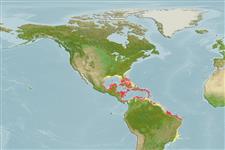Common names from other countries
>
Perciformes/Serranoidei (Groupers) >
Liopropomatidae (Painted basslets) > Liopropomatinae
Etymology: Liopropoma: Greek, leio = smooth + Greek, pro = in front of + Greek, poma, -atos = cover, operculum (Ref. 45335).
More on author: Poey.
Environment: milieu / climate zone / depth range / distribution range
Ecología
marino asociado a arrecife; rango de profundidad 3 - 45 m (Ref. 9710). Tropical
Western Atlantic: southern Florida, USA and Bahamas to northern South America.
Tamaño / Peso / Age
Maturity: Lm ? range ? - ? cm
Max length : 10.0 cm TL macho / no sexado; (Ref. 26938)
Espinas dorsales (total) : 6 - 7; Radios blandos dorsales (total) : 12. Body yellow-orange with 5 wide black lines along side bordered by red above and below. Large black spot on second dorsal fin; similar spot on anal fin; caudal fin has 2 black spots connected by black bar.
A solitary species (Ref. 26340) inhabiting deep recesses of coral reefs. Common, but secretive and rarely seen (Ref. 9710). The maximum size for this species is about 8 cm standard length or 100 mm TL (value from Ref. 26938) (P.Heemstra, pers.comm. 12/09).
Life cycle and mating behavior
Maturities | Reproducción | Spawnings | Egg(s) | Fecundities | Larva
Robins, C.R. and G.C. Ray, 1986. A field guide to Atlantic coast fishes of North America. Houghton Mifflin Company, Boston, U.S.A. 354 p. (Ref. 7251)
IUCN Red List Status (Ref. 130435)
CITES (Ref. 128078)
Not Evaluated
Threat to humans
Harmless
Human uses
Pesquerías: comercial; Acuario: Comercial
Herramientas
Special reports
Download XML
Fuentes de Internet
Estimates based on models
Preferred temperature (Ref.
115969): 25.4 - 28, mean 27.2 (based on 200 cells).
Phylogenetic diversity index (Ref.
82804): PD
50 = 0.5000 [Uniqueness, from 0.5 = low to 2.0 = high].
Bayesian length-weight: a=0.01122 (0.00514 - 0.02450), b=3.04 (2.87 - 3.21), in cm Total Length, based on all LWR estimates for this body shape (Ref.
93245).
Nivel trófico (Ref.
69278): 3.7 ±0.6 se; based on size and trophs of closest relatives
Fishing Vulnerability (Ref.
59153): Low vulnerability (10 of 100).
